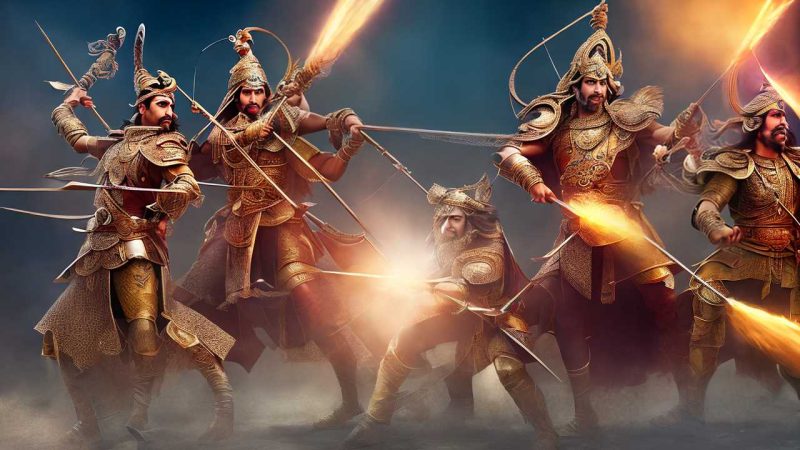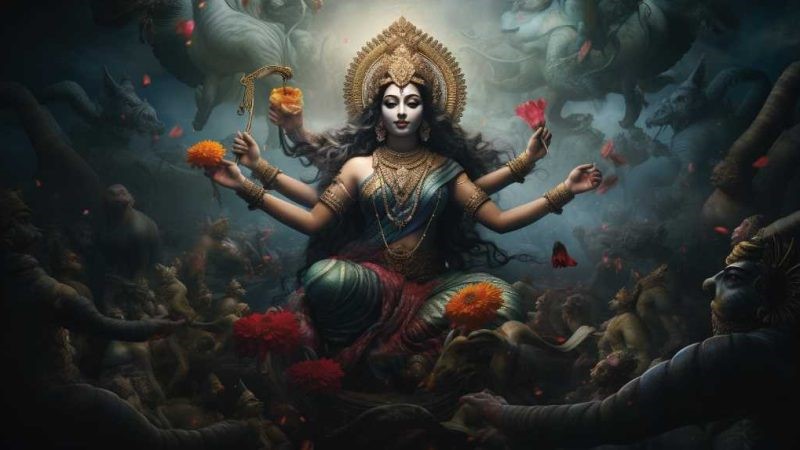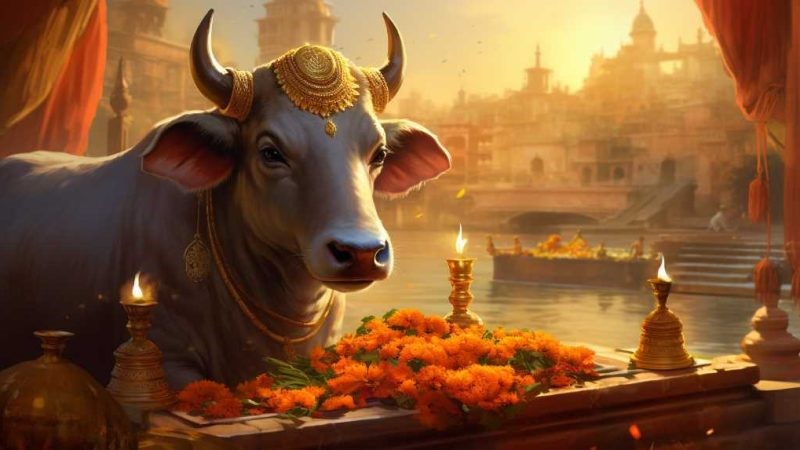Revealing the Lesser-Known Hindu Mythological Stories

In the vast collection of Hindu mythology, most people know the stories from the Mahabharata and the Ramayana, as well as tales about gods like Krishna and Shiva. But there are many other interesting stories in the sacred texts and oral traditions that are not as well-known. These stories can teach us more about Hindu philosophy, culture, and spirituality.
For example, there’s the story of Sage Atri’s birth, which illustrates the power of meditation and the importance of divine lineage in Hindu belief. The clever tricks of Mohini, an avatar of the god Vishnu, show the value of intelligence and the complexities of gender roles in mythology.
King Nahusha’s story tells us about the dangers of pride and how even the mighty can fall due to their arrogance. Anasuya’s unwavering devotion to her husband offers a lesson in faith and loyalty, and the story of Varaha, an avatar of Vishnu who lifts the Earth out of the cosmic ocean, symbolizes the triumph of good over evil.
Understanding these stories can offer new perspectives and enrich our knowledge of Hindu traditions. They remind us that there are always new things to learn from the past, and we can apply these lessons to our lives today. As we explore these tales, we see how they fit into the larger picture of Hindu teachings and how they can provide wisdom for our own experiences.
The Birth of Sage Atri
In Hindu stories, Sage Atri’s birth is an important event. He is one of the seven great sages, known as Saptarishis. Atri’s story is about how the divine and dedication to spiritual practice come together. The ancient Puranic texts say that Atri was born directly from Brahma, who is the god of creation. This shows that Atri has a special connection to the divine.
Atri’s birth is not only sacred but also shows how significant he is in the universe. He plays a key role, acting as a link between heaven and earth. Plus, his family goes on to be very influential in Hindu teachings.
Let’s make this clearer: Sage Atri is like a bridge that connects the spiritual world to our world. Because of his unique birth, coming right from a god, he is more than just a wise man; he’s a part of the spiritual foundation of Hindu belief. His life and teachings have a big impact on the religion, shaping how people understand and connect with the divine.
Mohini’s Enchanting Trickery
In the many stories from Hindu myths, Mohini’s story stands out because she’s a clever and charming character who plays a big part in important events. Mohini is a special form of the god Vishnu, and she’s known for being incredibly attractive and smart. Her most famous story is about how she tricked the bad guys, called Asuras, and gave a life-giving drink, amrita, to the good gods, the Devas. This story teaches us that sometimes it’s okay to use tricks if it’s for a good cause, and it also shows us that beauty doesn’t last forever and can be used to achieve bigger goals. Mohini is more than just a character who tricks others; she represents the balance between doing what’s right and the world of illusions in Hindu beliefs.
In this story, when the Devas and Asuras worked together to get amrita by churning the ocean, Vishnu turned into Mohini to solve a problem. The Asuras wanted to keep all the amrita for themselves, which was unfair. So, Vishnu became Mohini and used her charm to distract the Asuras. This way, the Devas got the amrita, which was crucial because it meant that the good forces stayed strong. This example shows how cleverness and beauty were used to keep things balanced and fair. Mohini’s actions are a reminder that sometimes difficult situations need smart and unexpected solutions.
King Nahusha’s Celestial Punishment
King Nahusha’s story is a powerful example from Hindu mythology that shows how acting too proudly can lead to serious consequences. Nahusha was made the temporary king of heaven, and he started off as a fair leader. However, he became too proud and started to act wrongly. He even demanded that wise men carry him around, which was a sign that he thought he was more important than he really was.
When he disrespected the wise sage Agastya, he was punished for it. Agastya turned him into a serpent, which was a way to fix the wrong Nahusha had done and teach him a lesson. This story teaches us that to be in charge of something as important as heaven, you must be good and humble. It also shows us that if someone becomes too self-centered, the world has a way of balancing things out again.
For example, it’s like when a team leader starts to ignore the team’s ideas and makes all decisions alone. If the team fails because of this, it’s a lesson that leadership should be about listening and working together, not just giving orders.
The Legend of Anasuya and the Tridev
The story of Anasuya and the Tridev is about devotion and the power of good over gods. Anasuya, known for her loyalty and the wife of the sage Atri, is praised for her strong commitment and spiritual strength. The three main gods in Hinduism—Brahma, Vishnu, and Shiva—came to her as beggars. They asked for food but wanted Anasuya to serve them without any clothes on. Using her wit, she turned them into babies, showing that her goodness was stronger than the test the gods gave her. This story tells us that being morally right can have a big impact, even on the rules of the universe.
In this tale, it’s clear that Anasuya’s good character was more powerful than the gods’ challenge. By turning the gods into infants, she showed that the right actions can lead to unexpected and positive outcomes. This example demonstrates the importance of sticking to one’s principles and the potential to alter even what seems unchangeable.
The story is a reminder that true virtue can lead to extraordinary results and can be more influential than we might think.
Varaha: The Boar Avatar’s Adventure
Just as Anasuya’s story illustrates the transformative power of virtue, the tale of Varaha, the Boar Avatar, reveals the divine’s capacity to assume formidable forms to restore cosmic balance.
In Hindu mythology, Varaha is the third avatar of Vishnu, emerging to defeat the demon Hiranyaksha who had submerged the Earth, personified as the goddess Bhudevi, into the cosmic ocean. The Varaha Purana and other texts describe this avatar’s Herculean quest to uplift the Earth, thus maintaining dharma, the eternal order.
This narrative encapsulates the theme of divine intervention in times of cosmic crisis. Varaha’s descent is symbolic of the transcendental nature of Vishnu, whose avatars incarnate to re-establish righteousness.
The story showcases the intricate interplay between the divine and the earthly realms, reflecting a worldview where deities actively participate in the world’s ongoing evolution and preservation.
Conclusion
Exploring Hindu myths that aren’t well-known can teach us a lot about Hindu beliefs and culture. For example, the story of Sage Atri’s birth shows us how Hindus view the universe. Mohini’s clever tricks teach us about Hindu ideas of cunning and trickery. King Nahusha and Anasuya’s stories give us lessons on how to live a good life, and the tale of Varaha talks about how order is important in the world. These stories are more than just entertainment—they help us understand the deep thoughts and moral rules that have been part of Hindu thinking for thousands of years.
Let’s make it simple. When we look at the birth of Sage Atri, we see a story about the universe’s workings. Mohini’s story is a fun way to learn about intelligence and deception. The tales of King Nahusha and Anasuya offer advice on living with integrity. The story of Varaha shows how chaos turns into order. These aren’t just random stories; they’re lessons on life and the universe, told in a way that has informed Hindu beliefs for a very long time.
Remember, these myths are more than ancient tales. They offer a window into the values and philosophies that are central to Hindu culture. It’s like getting an insider’s look at the building blocks of Hindu thought.






